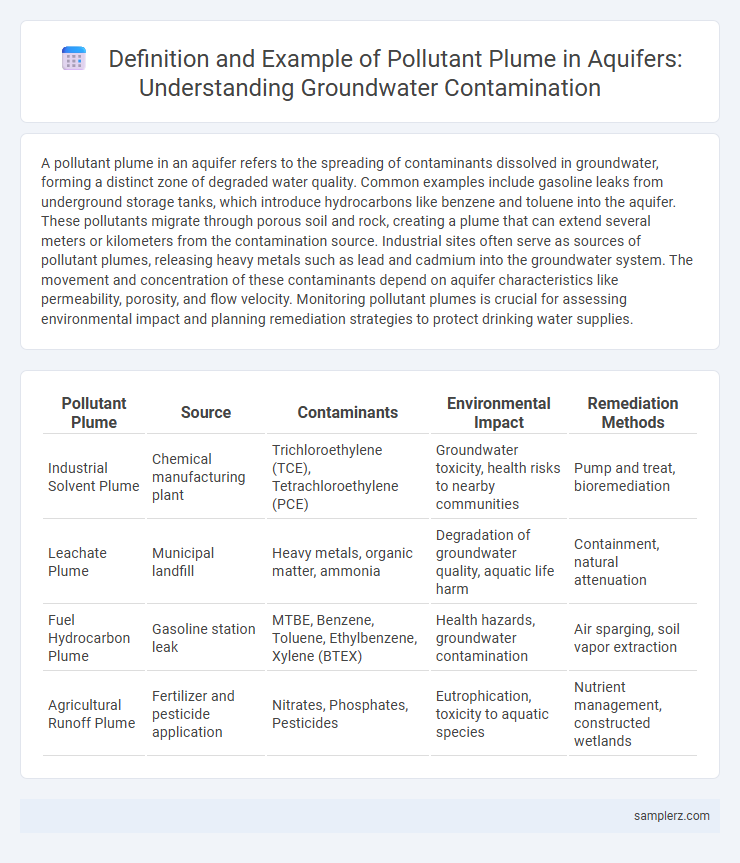A pollutant plume in an aquifer refers to the spreading of contaminants dissolved in groundwater, forming a distinct zone of degraded water quality. Common examples include gasoline leaks from underground storage tanks, which introduce hydrocarbons like benzene and toluene into the aquifer. These pollutants migrate through porous soil and rock, creating a plume that can extend several meters or kilometers from the contamination source. Industrial sites often serve as sources of pollutant plumes, releasing heavy metals such as lead and cadmium into the groundwater system. The movement and concentration of these contaminants depend on aquifer characteristics like permeability, porosity, and flow velocity. Monitoring pollutant plumes is crucial for assessing environmental impact and planning remediation strategies to protect drinking water supplies.
Table of Comparison
| Pollutant Plume | Source | Contaminants | Environmental Impact | Remediation Methods |
|---|---|---|---|---|
| Industrial Solvent Plume | Chemical manufacturing plant | Trichloroethylene (TCE), Tetrachloroethylene (PCE) | Groundwater toxicity, health risks to nearby communities | Pump and treat, bioremediation |
| Leachate Plume | Municipal landfill | Heavy metals, organic matter, ammonia | Degradation of groundwater quality, aquatic life harm | Containment, natural attenuation |
| Fuel Hydrocarbon Plume | Gasoline station leak | MTBE, Benzene, Toluene, Ethylbenzene, Xylene (BTEX) | Health hazards, groundwater contamination | Air sparging, soil vapor extraction |
| Agricultural Runoff Plume | Fertilizer and pesticide application | Nitrates, Phosphates, Pesticides | Eutrophication, toxicity to aquatic species | Nutrient management, constructed wetlands |
Overview of Pollutant Plumes in Aquifers
Pollutant plumes in aquifers typically originate from sources such as leaking underground storage tanks, agricultural runoff, or industrial spills, leading to the migration of contaminants like nitrates, heavy metals, and petroleum hydrocarbons through groundwater. The shape and extent of these plumes are influenced by hydrogeological factors including aquifer permeability, groundwater flow velocity, and chemical reactions between pollutants and soil minerals. Understanding the transport mechanisms and natural attenuation processes is crucial for effective remediation and protection of potable water supplies.
Common Sources of Aquifer Contamination
Pollutant plumes in aquifers commonly originate from agricultural runoff, industrial waste discharge, and leaking underground storage tanks, which introduce nitrates, heavy metals, and hydrocarbons into groundwater systems. Landfills and septic systems also contribute to aquifer contamination by releasing organic compounds and pathogens. These sources create dispersed zones of contamination that threaten water quality and pose significant risks to human health and ecosystems.
Case Study: Nitrate Plume Migration
Nitrate plume migration in aquifers is a common example of groundwater contamination caused by agricultural runoff and septic systems. The case study of the Central Valley, California, highlights how high nitrate concentrations exceed EPA's maximum contaminant level (MCL) of 10 mg/L, posing risks to drinking water quality and public health. Monitoring data reveal the plume's directional flow aligns with groundwater gradients, necessitating targeted remediation strategies to prevent further spread and ensure safe water supplies.
Industrial Chemicals: Trichloroethylene in Groundwater
Trichloroethylene (TCE) is a common industrial solvent that frequently contaminates groundwater aquifers through pollutant plumes originating from manufacturing sites and improper chemical disposal. These TCE plumes pose significant environmental and public health risks due to their persistence, toxicity, and potential to migrate over long distances within aquifer systems. Advanced monitoring and remediation techniques, such as pump-and-treat and in-situ chemical oxidation, are critical for managing TCE contamination in groundwater resources.
Hydrocarbon Plumes from Fuel Spills
Hydrocarbon plumes from fuel spills in aquifers pose significant risks to groundwater quality due to the migration of dissolved contaminants such as benzene, toluene, ethylbenzene, and xylene (BTEX compounds). These plumes result from petroleum leakage at underground storage tanks or pipeline failures, leading to the contamination of drinking water sources and ecosystems. Monitoring and remediation techniques like pump-and-treat systems and bioremediation are critical to managing hydrocarbon plume dispersion and mitigating long-term environmental impacts.
Heavy Metal Contamination in Aquifer Systems
Heavy metal contamination in aquifer systems is often exemplified by pollutant plumes originating from industrial sites where metals like lead, cadmium, and arsenic leach into groundwater. These plumes spread through the porous media of aquifers, causing widespread ecological and human health risks due to toxic metal accumulation. Remediation strategies focus on plume characterization using geochemical modeling and in-situ treatments to prevent further dispersion and restore water quality.
Agricultural Runoff and Pesticide Plumes
Agricultural runoff containing fertilizers and pesticides often generates pollutant plumes in aquifers, significantly impacting groundwater quality. Nitrate concentrations in these plumes frequently exceed EPA maximum contaminant levels, causing health risks such as methemoglobinemia in infants. Monitoring pesticide compounds like atrazine and chlorpyrifos in affected aquifers is critical for managing pollution sources and protecting drinking water supplies.
Leachate Plumes from Landfills
Leachate plumes from landfills represent a significant pollutant source in aquifers, typically containing high concentrations of heavy metals, organic compounds, and nitrates that degrade groundwater quality. These plumes migrate through subsurface pathways, posing risks to drinking water supplies and aquatic ecosystems by introducing toxic substances and increasing biochemical oxygen demand. Monitoring and remediation strategies for landfill leachate plumes focus on identifying contaminant dispersion patterns and implementing barriers or treatment systems to prevent aquifer contamination.
Saltwater Intrusion and Salinity Plumes
Saltwater intrusion occurs when seawater encroaches into freshwater aquifers, elevating salinity levels and degrading water quality in coastal regions. Salinity plumes, often originating from industrial discharge or agricultural runoff, migrate through subsurface layers, disrupting the natural dilution of groundwater. Monitoring these pollutant plumes using geochemical tracers and hydrological models is essential for managing aquifer vulnerability and protecting potable water supplies.
Monitoring and Modeling Aquifer Pollutant Plumes
Monitoring and modeling aquifer pollutant plumes involve advanced techniques such as groundwater sampling, geophysical surveys, and numerical simulations to accurately track contaminant transport and dispersion. High-resolution data from piezometers and multilevel wells enable detailed spatial analysis of plume dynamics, enhancing predictive models like MODFLOW and MT3DMS. These integrated approaches support effective remediation strategies by identifying pollutant sources, flow pathways, and temporal changes in aquifer contamination.

example of pollutant plume in aquifer Infographic
 samplerz.com
samplerz.com